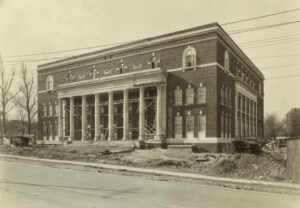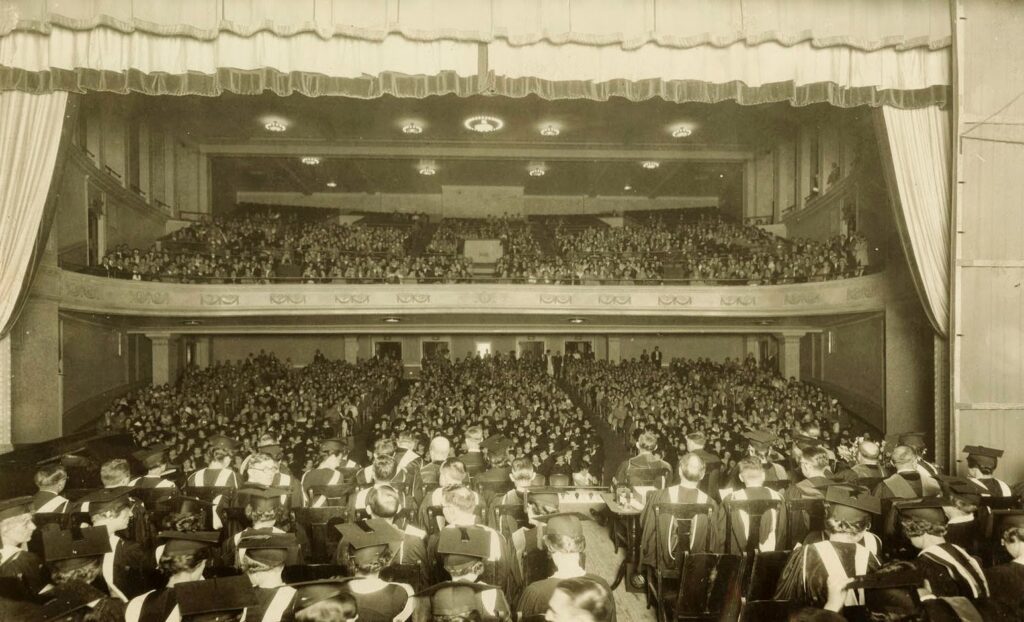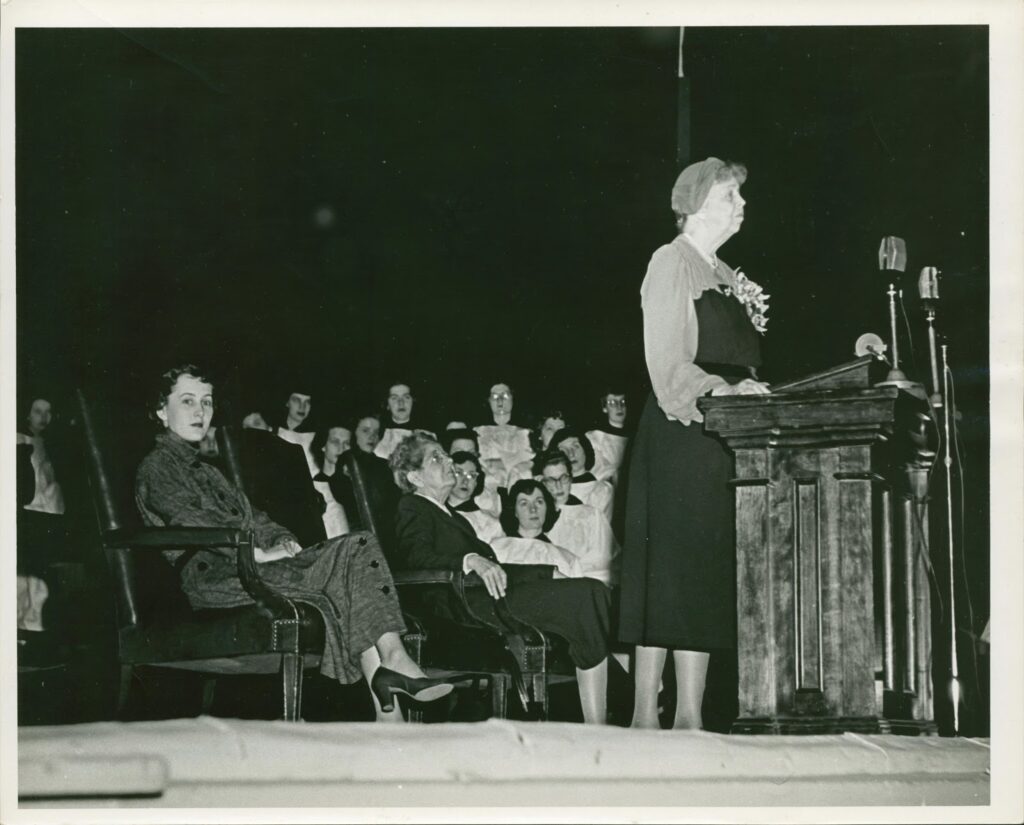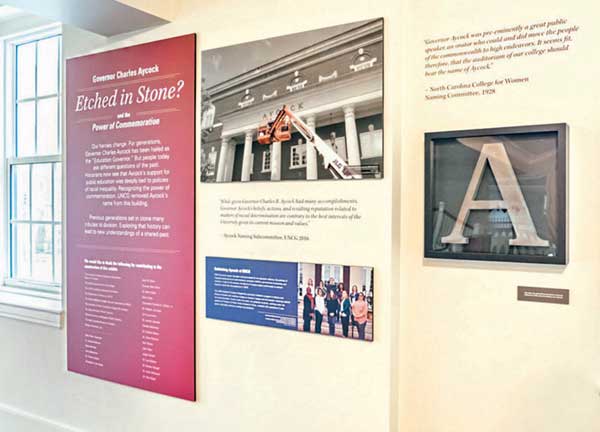In 1927, the building now known as UNCG Auditorium was opened as part of the June commencement exercises at the school (then named the North Carolina College for Women). The building’s primary purpose was to serve as a campus meeting space, replacing the 800-seat auditorium in the Students Building, which by 1927 could hold less than half the student body. Drama professor Raymond Taylor also persuaded campus administration to make the new auditorium a performance venue. Once completed, the auditorium reportedly had the largest capacity of any building in Greensboro – outside of the local tobacco warehouses.

January 5, 1927
One year and two weeks after the auditorium’s official opening, an Alumnae Committee of the Board of Directors of the College in June 1928 put forward honorific names for not just the auditorium, but also the new campus gymnasium and two new dormitories. For the auditorium, the committee recommended that it be named in honor of former North Carolina governor Charles Aycock. The committee wrote:
“For the new auditorium we propose the name Aycock Auditorium. It is almost superfluous to remind ourselves that Governor Aycock was the great apostle of public education in North Carolina, that he shared with our first president, Dr. McIver, the place that this college might have in contributing to this ideal, and that he was the constant friend in her times of prosperity and notably in one of her great crises, the fire.
Governor Aycock was preeminently a great public speaker, an orator who could and did move the people of this commonwealth to high endeavors. It seems fitting, therefore, that the auditorium of our college should bear the name of Aycock.”

From its opening, the auditorium also served as a major site for community events. The Greensboro Civic Music Society, which organized in 1927, made full use of the auditorium from the beginning. A number of local organizations and clubs also hosted musical and theater performances in the space. Regular chapel services on campus were moved to the auditorium – along with all student body meetings, campus performances and speakers, and every commencement exercise for the next thirty years. Guest lectures from individuals like Eleanor Roosevelt, Edna St. Vincent Millay, Ralph Abernathy, and Jane Goodall were held in the auditorium.

A renovation project funded by the citizens of North Carolina through the 2000 Higher Education Bond Referendum began in 2006. Significant “qualities of excellence” were also included in the renovation due to external funding from donors who supported the project through the campus Students First Campaign. The auditorium reopened in September 2008 with about 700 fewer seats but featuring expanded leg room, wider seats, an elevator, improved acoustics and sight lines, and many other bells and whistles.
In 2014, an ad hoc committee was formed to gather information for the Board of Trustees to use in determining whether or not to remove Governor Aycock’s name from the auditorium. This committee explored the historical connection between Aycock and UNCG, reported on renaming processes at other institutions, and collected feedback from the campus community through two public forums and an online survey.
In the end, to quote from the final report which was presented to the Board of Trustees in May 2015, “the members of the Aycock Ad Hock Committee were divided as to whether the Aycock name should be removed or retained. This division mirrors the opinions expressed in the feedback gathered by the committee. The Committee does agree unanimously that no matter whether the name is retained or removed, action should be taken by installing permanent exhibits, plaques, and/or an art installation, along with educational programs and dialogue, to explore this complicated history.”
The report also states the key points of concern on both sides of the debate. Those in favor of removing Aycock’s name argued that “Governor Aycock was not just a believer in white supremacy but was an architect of the White Supremacy Campaign that incited white citizens to participate in electoral fraud and the murder of Black citizens. Keeping the Aycock name on a prominent campus building does not foster the environment of inclusive excellence and diversity UNCG currently strives to create.”
Those opposed argued that “Removing the name is an effort to rewrite or whitewash history. Removing the name does nothing to address or ameliorate the racial injustices of the past. [And] retaining the name actually provides more opportunities to learn about and engage in dialogue about UNCG’s past, including the fact that at one time UNCG decided to honor a man whose values are at odds with those of the UNCG community today.”
The Board of Trustees in turn appointed a second committee, which, in February 2016, recommended the removal of Aycock’s name from the auditorium. They found that “while given Governor Charles B. Aycock had many accomplishments, Governor Aycock’s beliefs, actions, and resulting reputation related to matters of racial discrimination are contrary to the best interests of the University given its current mission and values.”

Current Chancellor Franklin Gilliam also released a statement on the removal of the Aycock name that point-by-point addressed many of the issues initially raised by the initial Ad Hoc Committee members who were in opposition to renaming. His statement included a personal anecdote about his feelings as a young Black faculty member at UCLA every time he saw a bust of Ralph Bunche that was next to the elevator leading to his office. No African American faculty member had received tenure in his department at that point. But he saw this bust daily and described feeling a “boost” to his “self-worth” each time he saw it. He concluded “Don’t underestimate the power of symbolism. Trivial in the minds of some? Maybe. Pivotal in the lives of others? Yes.”

In April 2018, the University unveiled a new exhibit exploring Aycock’s legacy as well as the politics of commemoration in the second floor lobby of UNCG Auditorium. This exhibit, titled “Etched in Stone?: Governor Charles Aycock and the Power of Commemoration” was developed by students in UNCG’s museum studies program, a two-year master’s program in the history department. In 2019, the exhibit was presented the Award of Excellence from the American Association for State and Local History, the nation’s most prestigious competition for recognition of achievement in state and local history.